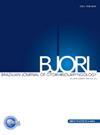Definitive treatment in squamous cell carcinoma of head and neck: A retrospective analysis of chemoradiotherapy in a university hospital setting
IF 1.7
4区 医学
Q2 OTORHINOLARYNGOLOGY
引用次数: 0
Abstract
Objective
To evaluate toxicities, tumor control, Event-Free Survival (EFS) and Overall Survival (OS) of patients with locoregionally advanced Head and Neck Squamous Cell Carcinoma (HNSCC) treated with definitive platinum-based Chemoradiation (CTRT).
Methods
A total of 233 patients underwent treatment with RT plus weekly or every three weeks Cisplatin (CDDP) or Carboplatin (Carbo). Toxicity and response to treatment were classified using conventional criteria. Kaplan-Meier, log-rank test, and Cox regression (univariate and multivariate) were used to assess patient survival.
Results
Half of patients presented toxicities grade 3 or 4, with nausea/vomiting and nephrotoxicity being more common in RT and CDDP group and anemia and neutropenia in RT and Carbo group. Complete or partial response was observed in 75% of patients, and the distinct protocols did not alter the treatment response. Two-year EFS and OS probabilities were 43.3% and 66.0%, respectively. Active smoking, an ECOG score of 2 or higher, stage IV tumor, and treatment with RT and Carbo were independent prognostic factors for poorer outcomes. Patients of these groups had approximately double chance of relapse and progression to death compared to others.
Conclusion
Our data indicate definitive treatment with RT and CDDP as the best treatment for locoregionally advanced HNSCC treated in Brazilian public hospitals. However, prospective randomized studies are required to establish the ideal treatment for those patients.
Level of evidence
3.
求助全文
约1分钟内获得全文
求助全文
来源期刊

Brazilian Journal of Otorhinolaryngology
OTORHINOLARYNGOLOGY-
CiteScore
3.00
自引率
0.00%
发文量
205
审稿时长
4-8 weeks
期刊介绍:
Brazilian Journal of Otorhinolaryngology publishes original contributions in otolaryngology and the associated areas (cranio-maxillo-facial surgery and phoniatrics). The aim of this journal is the national and international divulgation of the scientific production interesting to the otolaryngology, as well as the discussion, in editorials, of subjects of scientific, academic and professional relevance.
The Brazilian Journal of Otorhinolaryngology is born from the Revista Brasileira de Otorrinolaringologia, of which it is the English version, created and indexed by MEDLINE in 2005. It is the official scientific publication of the Brazilian Association of Otolaryngology and Cervicofacial Surgery. Its abbreviated title is Braz J Otorhinolaryngol., which should be used in bibliographies, footnotes and bibliographical references and strips.
 求助内容:
求助内容: 应助结果提醒方式:
应助结果提醒方式:


